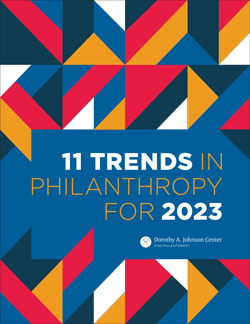The Public is Holding Nonprofits Accountable to Living Their Mission and Values


 This article was first published in our 11 Trends in Philanthropy for 2023 report. Explore all 11 trends in the report.
This article was first published in our 11 Trends in Philanthropy for 2023 report. Explore all 11 trends in the report.
Want the latest trends, research, and more delivered right to your inbox? Subscribe to the Johnson Center email newsletter.
In July 2022, Public Allies, a national nonprofit committed to “advancing social justice and equity by engaging and activating the leadership of all people” (para. 1), laid off 30 employees and closed nine of its 22 sites without notice (Rodriguez, 2022).
Ninety-two percent of those employees were people of color; 58% were Black women, according to alumni (Woods, 2002). Ironically, months earlier, Public Allies received a $10 million gift from MacKenzie Scott to support the organization’s Racial Equity Fundraising Campaign. Then-CEO Jaime Ernesto Uzeta cited restructuring in an announcement of the changes, but Public Allies program alumni claimed that those laid off were targeted for openly voicing concerns about Uzeta’s negligent oversight of operations and programs.
Public Allies supporters and alumni quickly rallied against the changes, creating a website to support affected Public Allies sites and staff. Among other things, they demanded accountability for the CEO’s perceived inability to align with Public Allies’ stated core values and mission. Uzeta resigned a few weeks later (Save Public Allies, 2022).
“Publicly-stated missions are a form of accountability — something to measure an organization’s and a leader’s actions against.”
Public accountability is woven into the fabric of many social structures. Public officials in government are directly accountable to their constituents and must be elected and reelected by those they serve. In the nonprofit sector, organizations are meant to be accountable to their boards, donors, community partners, staff members, grantees, and volunteers. However, the methods for holding a nonprofit organization accountable — for their actions, fiscal choices, community relationships, etc. — have not always been so clear, accessible, or publicized.
That seems to be changing now.
The shift began in the early 2000s, with an increased focus on fiscal accountability in nonprofit organizations following a series of scandals in the sector. Issues at United Ways in Washington D.C., New York City, and Charlotte, North Carolina (Melen, 2020) — among other events — heightened insistence that organizations practice their values and mission internally and externally.
During this time, the Internal Revenue Service Form 990, an annual tax return filed by charities, became more widely used as a tool for public transparency. In 2008, the IRS redesigned its format to make the Form 990 more informative and understandable. When the IRS began releasing Forms 990 data en masse via the internet in 2016, public accessibility improved (Howard, 2016). The result has been increased transparency into how individual organizations and the whole of the sector receive, distribute, and use charitable dollars:
A journalist at The Boston Globe identified over 1,100 nonprofits nationally that had reported some form of fraud or embezzlement to the IRS — few, if any, of whom had previously received media attention (Strohecker, 2018).
(See Use Cases from Publicly Available IRS Form 990 Data for these and other examples, Dorothy A. Johnson Center for Philanthropy, 2022.)
Form 990 has its limits, however. The connection between financial information and the mission often gets buried behind financial management issues; Form 990 gives little insight into how an organization lives its mission in its daily internal operations. This is one reason why sector actors — including the Johnson Center — are now pushing for even more data on philanthropy and more partnership with communities to share it (Schuman Ottinger & Williams, 2022). That said, financial accountability is only one piece of the puzzle.
Nonprofits may never be influenced by such direct public accountability measures as elections, but public pressure can be powerful. There are an increasing number of examples — like Public Allies — where nonprofit organizations and their executive staff have failed to reflect their mission in their work, and that misalignment has garnered national media attention. Under pressure to prioritize stated values over high-profile leaders, these organizations have been forced to respond:
In 2019, Morris Dees, co-founder of the Southern Poverty Law Center, one of the nation’s most prominent civil rights groups, was ousted for misconduct after nearly 50 years with the organization. A letter signed by staffers alleged “a widespread pattern of racial and gender discrimination” (Moser, para. 11), including sexual harassment claims and mistreatment that went unaddressed.
TIME’S UP, a nonprofit organization that “aims to create a society free of gender-based discrimination in the workplace and beyond” (2022, para. 2), grew out of the #MeToo Movement. Yet, according to an investigation from The New York Times (Kantor, 2021), leaders within the charity advised former New York Gov. Andrew Cuomo on handling his sexual assault allegations. To many TIME’S UP supporters, those leaders’ actions appeared at odds with the organization’s stated mission. Public outcry forced CEO Tina Tchen to resign (Kantor, 2021).
The internet and social media have played undeniably significant roles in these outcomes. It is clear now that even long-time executives are no longer considered unassailable, which is having a snowball effect in every sector. The difference here may be the particular nature of mission-focused work. Publicly-stated missions are a form of accountability — something to measure an organization’s and a leader’s actions against.
Other stories have arguably happier endings; “accountability” is not inherently meant to be punitive. It is intended to lead to improvements and growth. At the beginning of 2018, for example, the Washington, D.C.-based Center on Budget and Policy Priorities publicly advocated for a national paid family leave program — but offered their employees only two weeks of paid parental leave. By the end of the year, CBPP’s staff had formed a union and won a new contract guaranteeing 12 weeks of paid family leave (Rosenberg, 2020). In this case, organizational leadership was ultimately seen as supportive of staff and willing to change.
Further, many nonprofit boards already hold themselves accountable by including community representatives in their decision-making — as staff, volunteers, advisors, and as board members themselves. As more nonprofits and foundations open up their operations to all their stakeholders — embracing greater inclusion, strategies like participatory grantmaking, or changing how they monitor and evaluate their programs — more people will come to expect and wield opportunities for accountability. Whether and how these efforts lead to more significant mission impact has yet to be seen.


Dorothy A. Johnson Center for Philanthropy. (2022, April 6). Use cases from publicly available IRS Form 990 data. https://johnsoncenter.org/resource/use-cases-from-publicly-available-990-data/
Howard, A. (2016, June 16). IRS opens up Form 990 data, ushering nonprofit sector into the age of transparency. Sunlight Foundation. https://sunlightfoundation.com/2016/06/16/irs-opens-up-form-990-data-ushering-nonprofit-sector-into-the-age-of-transparency/
James, L. (2022, February 23). Attorney General James delivers over $640,000 to New York breast cancer organizations. NY Attorney General. https://ag.ny.gov/press-release/2022/attorney-general-james-delivers-over-640000-new-york-breast-cancer-organizations
Kantor, J., Sundaram, A., & Ryzik, M. (2021, August 26) Time’s Up C.E.O. resigns amid crisis over Cuomo ties. The New York Times. https://www.nytimes.com/2021/08/26/business/times-up-tina-tchen.html
Melen, M. (2020, March 12). Facts about past United Way corruption and scandals. Love to Know. https://charity.lovetoknow.com/charitable-organizations/facts-about-past-united-way-corruption-scandals
Moser, B. (2019, March 21). The reckoning of Morris Dees and the Southern Poverty Law Center. The New Yorker. https://www.newyorker.com/news/news-desk/the-reckoning-of-morris-dees-and-the-southern-poverty-law-center
Public Allies. (2022) Who we are. https://publicallies.org
Redden, M. (2022, November 6). Trevor Project ousts CEO who played a role in the opioid crisis. HuffPost. https://www.huffpost.com/entry/amit-paley-ceo-trevor-project_n_6367e522e4b08f849aac58f4
Rodriguez, A. (2022, July 25) A nonprofit’s ‘restructuring’ halted years of progress on bringing AmeriCorps volunteers to Racine. The Journal Times. https://journaltimes.com/news/local/a-nonprofits-restructuring-halted-years-of-progress-on-bringing-americorps-volunteers-to-racine/article_cd5f088e-0859-11ed-a3ef-8319e25379f1.html
Rosenberg, E. (2020, February 4). Workers are forming unions at nonprofits and think tanks. Their bosses aren’t always happy. The Washington Post. https://www.washingtonpost.com/business/2020/02/04/workers-are-forming-unions-nonprofits-thinktanks-their-bosses-arent-always-happy/
Save Public Allies. (2022) https://savepublicallies.org
Schuman Ottinger, C., & Williams, J. (2022, September 8) Unlocking the potential of open 990 data. Stanford Social Innovation Review. https://ssir.org/articles/entry/unlocking_the_potential_of_open_990_data
Strohecker, P. (2018, March 9). How The Boston Globe uncovered fraud at Massachusetts nonprofits. Storybench. https://www.storybench.org/boston-globe-uncovered-fraud-massachusetts-nonprofits/
TIME’S UP. (2023) About. https://timesupfoundation.org/about/
Woods, S. (2022, July 14). Public allies CEO lays off employees, citing ‘restructuring’ needs, but alumni call move retaliation. Milwaukee Neighborhood News Service. https://milwaukeenns.org/2022/07/14/public-allies-ceo-lays-off-employees-citing-restructuring-needs-but-alumni-call-move-retaliation/